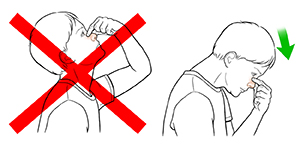When Your Child Has Nosebleeds
When Your Child Has Nosebleeds

What causes nosebleeds?
The skin inside your child’s nose is very delicate. It is filled with many tiny blood vessels. That’s why even a small injury can bleed a lot. The most common causes of nosebleeds in children are:
Nose picking
Dryness inside the nose
Allergies or colds
Certain medicines
Injury to the nose
Abnormal tissue growths such as polyps
How are nosebleeds treated?
Nosebleeds are easy to treat at home. With proper treatment, most nosebleeds will stop in less than 5 minutes. Keep this list of Do’s and Don’ts in mind:
DO
Have your child tilt his or her head slightly forward (NOT backward). This keeps blood from pooling at the back of the throat, where it may be swallowed.
Use a finger or small wad of tissue to firmly press against the nostrils (or the nostril that is bleeding). Press close to the opening of the nostril, not up by the bridge of the nose. Press firmly enough to close off the nostril.
Let your child sit down if he or she wants, but don’t let him or her lie down during a nosebleed.
Your child may wish to take it easy for the rest of the day after a nosebleed.
DON’T
Don’t have your child place his or her head between the knees. This is not needed, and may even make the nosebleed worse.
Don’t give your child a pain reliever. If your child needs one, call your healthcare provider.
Don’t put ice on the nose.
Don’t let your child lie down during the nosebleed.
If nosebleeds happen often
Most nosebleeds are not a medical emergency. But if your child is having nosebleeds often, take him or her to see a healthcare provider. Your child may need a saline (special saltwater) nasal spray to moisten the inside of the nose. In some cases, the healthcare provider may need to do a quick procedure to keep the vessels from bleeding.
How are nosebleeds prevented?
To help prevent nosebleeds in your child:
Apply petroleum jelly or antibiotic ointment to the inside of your child’s nose before bedtime.
Try to keep your child from picking his or her nose.
Turn down the house thermostat so air is not as dry and hot.
If needed, add moisture to the air in your child's room using a humidifier. Be sure to use fresh water daily, and clean the filter often to prevent bacterial growth in the humidifier.
Treat your child’s allergies, if needed.
When to call your child's healthcare provider
Call your child’s healthcare provider right away if your child has any of the following:
Nose that is still bleeding after 15 minutes of treatment listed above
Very heavy bleeding, with large clots visible
Daily nosebleeds that continue for 3 days
Bruising on the abdomen, backs of thighs, or buttocks. These are fleshy places that don’t normally bruise.
Small, flat purple spots (petechiae) anywhere on your child’s body
Pale skin or weakness anywhere in the body
Bleeding from a second area, such as the gums
Blood in the stool
Updated:
November 19, 2017
Reviewed By:
Bass, Pat F III, MD, MPH,Image reviewed by StayWell medical illustration team.,Kacker, Ashutosh, MD